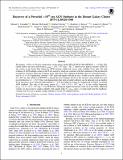| dc.contributor.author | Calzadilla, Michael S | |
| dc.contributor.author | McDonald, Michael A. | |
| dc.contributor.author | Bayliss, Matthew B | |
| dc.contributor.author | Benson, Bradford A | |
| dc.contributor.author | Bleem, Lindsey E | |
| dc.contributor.author | Brodwin, Mark | |
| dc.contributor.author | Edge, Alastair C | |
| dc.contributor.author | Floyd, Benjamin | |
| dc.contributor.author | Gupta, Nikhel | |
| dc.contributor.author | Hlavacek-Larrondo, Julie | |
| dc.contributor.author | McNamara, Brian R | |
| dc.contributor.author | Reichardt, Christian L | |
| dc.date.accessioned | 2022-07-27T20:07:43Z | |
| dc.date.available | 2021-09-20T18:22:36Z | |
| dc.date.available | 2022-07-27T20:07:43Z | |
| dc.date.issued | 2019 | |
| dc.identifier.uri | https://hdl.handle.net/1721.1/132472.2 | |
| dc.description.abstract | © 2019. The American Astronomical Society. All rights reserved. We present ∼103 ks of Chandra observations of the galaxy cluster SPT-CLJ0528-5300 (SPT0528, z = 0.768). This cluster harbors the most radio-loud (L 1.4GHz = 1.01 × 1033 erg s-1 Hz-1) central active galactic nucleus (AGN) of any cluster in the South Pole Telescope (SPT) Sunyaev-Zeldovich survey with available X-ray data. We find evidence of AGN-inflated cavities in the X-ray emission, which are consistent with the orientation of the jet direction revealed by Australia Telescope Compact Array radio data. The combined probability that two such depressions-each at ∼1.4-1.8σ significance, oriented ∼180° apart and aligned with the jet axis-would occur by chance is 0.1%. At ⪆1061 erg, the outburst in SPT0528 is among the most energetic known in the universe, and certainly the most powerful known at z > 0.25. This work demonstrates that such powerful outbursts can be detected even in shallow X-ray exposures out to relatively high redshifts (z ∼ 0.8), providing an avenue for studying the evolution of extreme AGN feedback. The ratio of the cavity power (Pcaw=(9.4 ±5.8)× 1045 erg s-1) to the cooling luminosity (L cool = (1.5 ± 0.5) × 1044 erg s-1) for SPT0528 is among the highest measured to date. If, in the future, additional systems are discovered at similar redshifts with equally high P cav/L cool ratios, it would imply that the feedback/cooling cycle was not as gentle at high redshifts as in the low-redshift universe. | en_US |
| dc.language.iso | en | |
| dc.publisher | American Astronomical Society | en_US |
| dc.relation.isversionof | 10.3847/2041-8213/AB5B07 | en_US |
| dc.rights | Article is made available in accordance with the publisher's policy and may be subject to US copyright law. Please refer to the publisher's site for terms of use. | en_US |
| dc.source | The American Astronomical Society | en_US |
| dc.title | Discovery of a Powerful >10 61 erg AGN Outburst in the Distant Galaxy Cluster SPT-CLJ0528-5300 | en_US |
| dc.type | Article | en_US |
| dc.contributor.department | MIT Kavli Institute for Astrophysics and Space Research | en_US |
| dc.contributor.department | Massachusetts Institute of Technology. Department of Physics | en_US |
| dc.relation.journal | Astrophysical Journal Letters | en_US |
| dc.eprint.version | Final published version | en_US |
| dc.type.uri | http://purl.org/eprint/type/JournalArticle | en_US |
| eprint.status | http://purl.org/eprint/status/PeerReviewed | en_US |
| dc.date.updated | 2020-11-03T18:10:38Z | |
| dspace.orderedauthors | Calzadilla, MS; McDonald, M; Bayliss, M; Benson, BA; Bleem, LE; Brodwin, M; Edge, AC; Floyd, B; Gupta, N; Hlavacek-Larrondo, J; McNamara, BR; Reichardt, CL | en_US |
| dspace.date.submission | 2020-11-03T18:10:48Z | |
| mit.journal.volume | 887 | en_US |
| mit.journal.issue | 1 | en_US |
| mit.license | PUBLISHER_POLICY | |
| mit.metadata.status | Publication Information Needed | en_US |
